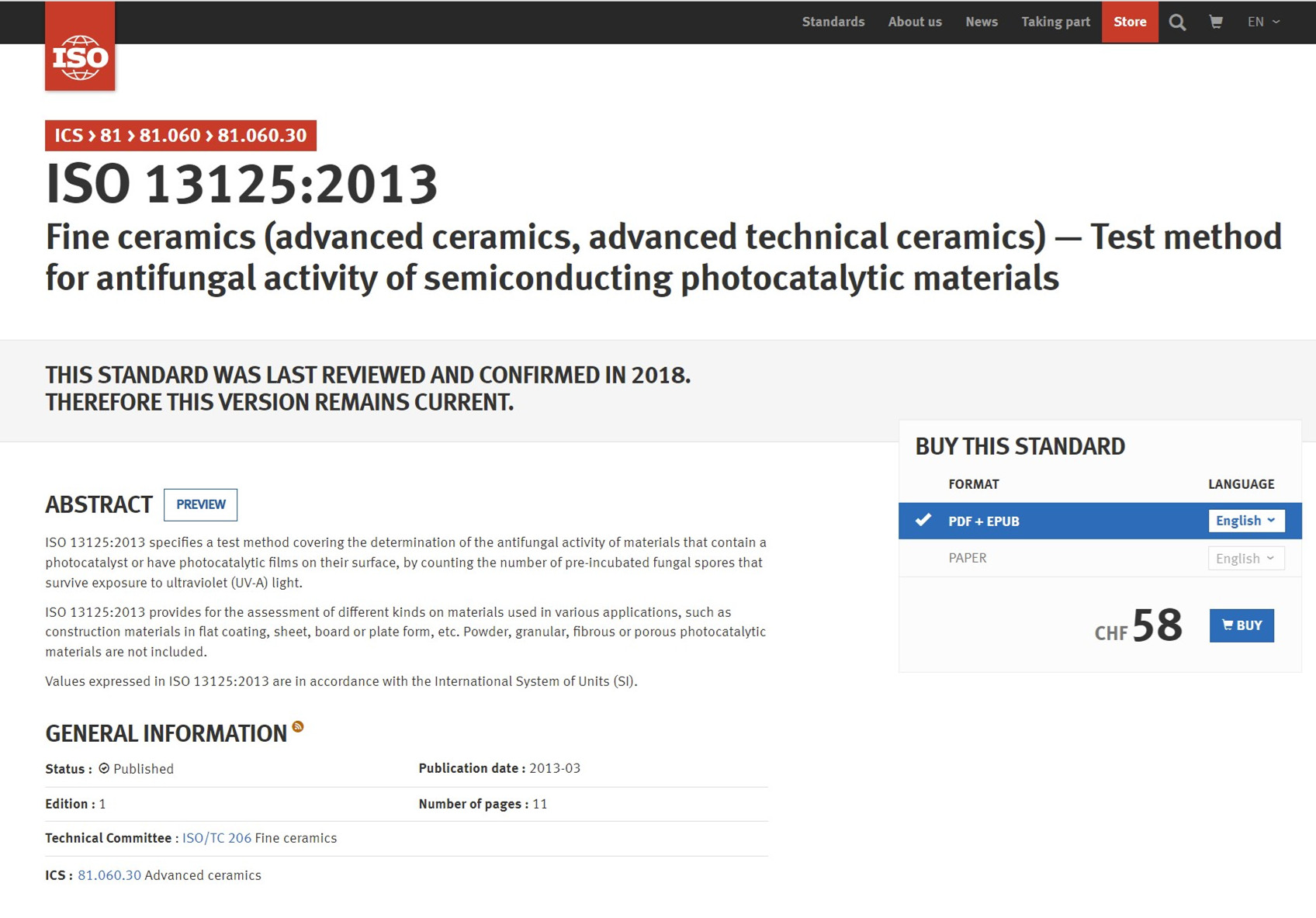精细陶瓷(高级陶瓷,高级工业陶瓷)--半导性光催化材料抗菌活性的试验方法
时间:2022-05-12 09:57:33 来源:ISO 点击量:

ISO 13125:2013
Fine ceramics (advanced ceramics, advanced technical ceramics) — Test method for antifungal activity of semiconducting photocatalytic materials
Introduction
Under the illumination of ultraviolet (UV) light, photocatalysts show diverse functions, such as the decomposition of air and water contaminants, as well as deodorization, self-cleaning, antifogging, antibacterial and antifungal actions. These functions of photocatalysts are generally based on the action of active oxygen species such as hydroxyl (OH) radicals formed on the surface of photocatalysts. The energy- and labour-saving nature of photocatalysis has attracted keen interest when the photocatalyst is activated by sunlight (or artificial lighting).
Practical applications of photocatalysts for both indoor and outdoor use have rapidly expanded in recent years. Many kinds of photocatalytic materials have been proposed or are already commercialized, based on ceramics, glass, concrete, plastics, paper, etc. Such materials have been proposed by either coating or mixing of a photocatalyst; in most cases, titanium dioxide (TiO2).
However, the effect of photocatalysis is not easily inspected visually, and no appropriate and standardized evaluation methods have been available to date. Some confusion has thus arisen as photocatalytic materials have been introduced. Furthermore, the above-mentioned diverse functions of photocatalysts cannot be evaluated with a single method: thus it is required to provide different evaluation methods for air purification, water decontamination, and self-cleaning.
This International Standard applies to testing the antifungal activity of photocatalytic ceramics and other materials.
WARNING Handling and manipulation of microorganisms that are potentially hazardous requires a high degree of technical competence. Only personnel trained in microbiological techniques should carry out the test.
1 Scope
This International Standard specifies a test method covering the determination of the antifungal activity of materials that contain a photocatalyst or have photocatalytic films on their surface, by counting the number of pre-incubated fungal spores that survive exposure to ultraviolet (UV-A) light.
This International Standard provides for the assessment of different kinds on materials used in various applications, such as construction materials in flat coating, sheet, board or plate form, etc. Powder, granular, fibrous or porous photocatalytic materials are not included.
Values expressed in this International Standard are in accordance with the International System of Units (SI).
2 Normative references
The following referenced documents are indispensable for the application of this document. For dated references, only the edition cited applies. For undated references, the latest edition of the referenced document (including any amendments) applies.
ISO 27447, Fine ceramics (advanced ceramics, advanced technical ceramics) — Test method for antibacterial activity of semiconducting photocatalytic materials
ISO 4892-3, Plastics — Methods of exposure to laboratory light sources — Part 3: Fluorescent UV lamps
IEC 60068-2-10, Environmental testing — Part 2-10: Test J and guidance: Mould growth
3 Terms and definitions
For the purposes of this document, the following terms and definitions apply.
3.1
photocatalyst
substance that carries out many functions based on oxidization and reduction reactions under UV irradiation, including decomposition and removal of air and water contaminants, deodorization, antibacterial, antifungal, self-cleaning and antifogging
3.2
photoirradiation
irradiation to ultraviolet (UV-A) light at wavelength 300 nm to 400 nm
3.3
photocatalytic materials
surface or material to which a photocatalyst has been applied with the intention of making it photocatalytically active; photocatalytic treated materials, samples and pieces are included
3.4
antifungal activity
inhibition of germination or inactivation of fungal spores
3.5
antifungal activity value in irradiation condition L
common logarithm of the ratio of the number of surviving fungal spores on a photocatalytic non-treated piece after UV irradiation condition L for a given period of time to the number of surviving spores on a treated piece after the same UV irradiation condition for the same period
3.6
antifungal activity value with UV irradiation by removing the effect in the dark
difference value between antifungal activity value in irradiation condition L and common logarithm of the ratio of the number of surviving fungal spores on a photocatalytic non-treated piece in the dark to the number of surviving spores on a treated piece stored in the dark for the same period of time
CIAA会员单位免费下载
